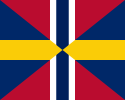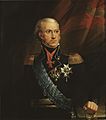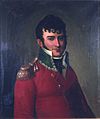Union of Sweden and Norway facts for kids
Quick facts for kids
United Kingdoms of Sweden and Norway
Förenade konungarikena Sverige och Norge
De forenede Kongeriger Norge og Sverige |
|||||||||||||
|---|---|---|---|---|---|---|---|---|---|---|---|---|---|
| 1814–1905 | |||||||||||||

Sweden and Norway in 1905
|
|||||||||||||
| Status | Personal union | ||||||||||||
| Capital | Stockholm & Christiania[a] | ||||||||||||
| Common languages | Swedish, Danish, Norwegian[b], Western Sami languages | ||||||||||||
| Religion | Protestant (Lutheran) Christianity | ||||||||||||
| Government | Constitutional monarchies | ||||||||||||
| King | |||||||||||||
|
• 1814–1818
|
Charles XIII/II | ||||||||||||
|
• 1818–1844
|
Charles XIV/III John | ||||||||||||
|
• 1844–1859
|
Oscar I | ||||||||||||
| Legislature | Legislatures:[d] | ||||||||||||
|
• Swedish legislature
|
Swedish Parliament | ||||||||||||
|
• Norwegian legislature
|
Parliament of Norway | ||||||||||||
| Historical era | 19th century | ||||||||||||
| 14 January 1814 | |||||||||||||
|
• Charles XIII elected king of Norway
|
4 November 1814 | ||||||||||||
|
• Constitution of Norway amended
|
4 November 1814 | ||||||||||||
|
• Monetary union
|
16 October 1875 | ||||||||||||
|
• Norway declares independence
|
7 June 1905 | ||||||||||||
|
• Union dissolved
|
13 August 1905 | ||||||||||||
|
• Oscar II renounces claims to Norway
|
26 October 1905 | ||||||||||||
| Area | |||||||||||||
| 1905 | 774,184 km2 (298,914 sq mi) | ||||||||||||
| Population | |||||||||||||
|
• 1820
|
3550000[c] | ||||||||||||
|
• 1905
|
7560000[c] | ||||||||||||
| Currency | Sweden: Riksdaler, (1814–1873) Krona (1873–1905) Norway: Speciedaler, (1814–1875) Krone (1875–1905) |
||||||||||||
|
|||||||||||||
|
a. ^ The king resided alternately in Stockholm (mostly) and Christiania (usually some months of each year). He received ministers from both Sweden and Norway in Union council, or separately in only Swedish or Norwegian councils. The majority of the Norwegian cabinet ministers convened in Christiania when the king was absent.
b. ^ The written Norwegian language ceased to exist in the first half of the 16th century and was replaced by Danish. Written Danish was still used during the union with Sweden, but was slightly norwegianized in the latter half of the 19th century. In 1885, the Parliament of Norway accepted Landsmål as an official written language at par with Danish. c. ^ 1820: 2,585,000 in Sweden, and 970,000 in Norway. 1905: 5,260,000 in Sweden, and 2,300,000 in Norway. d. ^ The Swedish Parliament was a diet composed of four estates until 1866. That year it became into a bicameral legislature. The Parliament of Norway was a unicameral legislature. In the Norwegian parliament the cabinet needed support from the majority. |
|||||||||||||
The Union of Sweden and Norway (Swedish: Svensk-norska unionen; Norwegian: Den svensk-norske union), officially called the United Kingdoms of Sweden and Norway, was a special partnership between the separate kingdoms of Sweden and Norway. These two countries shared the same king, but they kept their own laws, governments, and armies. The Union lasted from 1814 to 1905.
Even though they shared a king, the two countries were quite independent. They had their own constitutions, laws, and even their own money. The kings usually lived in Stockholm, Sweden's capital. This is also where other countries had their embassies.
Contents
How the Union Started
The Union of Sweden and Norway began in 1814. This happened after a big war in Europe called the Napoleonic Wars.
Treaty of Kiel and Its Impact
In 1814, a peace agreement called the Treaty of Kiel was signed. This treaty said that Denmark had to give Norway to Sweden. But Norway did not want to be ruled by Sweden.
Norway's Fight for Independence
The people of Norway wanted to be independent. They quickly wrote their own constitution on May 17, 1814. They also chose their own king, Christian Frederik.
Sweden did not agree with this. Sweden's Crown Prince, Charles John, led his army into Norway. This led to a short war between Sweden and Norway.
Joining the Union
The war ended with an agreement called the Convention of Moss. Norway agreed to join a union with Sweden. But Norway insisted on keeping its new constitution.
On November 4, 1814, the Norwegian Parliament (called the Storting) changed the constitution slightly. They then elected the Swedish king, Charles XIII, as their king. This officially created the Union of Sweden and Norway.
Life in the Union
For most of the Union's time, Sweden and Norway lived together peacefully. They shared a king and worked together on some things.
Even though they were in a union, Sweden and Norway remained separate countries. They each had their own:
- Laws and governments
- Armies and navies
- Churches
- Money systems
The king was the only thing they truly shared. He would spend most of his time in Stockholm, Sweden. But he would also visit Christiania (now Oslo), Norway's capital, for a few months each year.
Economic Cooperation
Over time, Sweden and Norway started to work together more on money matters. In 1875, they joined the Scandinavian Monetary Union. This meant they used the same type of money, the krona and krone, which had the same value. This made trade easier between the countries.
Growing Tensions and Dissolution
As the years passed, Norway wanted more independence. They felt that Sweden had too much control, especially in foreign affairs.
Norwegian Desire for More Control
Norway's economy grew, and its people felt stronger. They wanted their own foreign policy and their own consuls (officials who represent a country abroad). Sweden's king, Oscar II, was also the king of Norway. He controlled foreign policy, which upset many Norwegians.
The Flag Dispute
One of the issues was the flag. From 1844, both countries used a "union mark" in the corner of their flags. This mark showed they were united. But many Norwegians wanted to remove this mark from their merchant flag. They saw it as a symbol of Swedish dominance. In 1899, Norway removed the union mark from its merchant flag.
Norway Declares Independence
By the early 1900s, the disagreements became very serious. On June 7, 1905, the Norwegian Parliament declared that King Oscar II was no longer the King of Norway. They said the Union was dissolved.
Peaceful Separation
Sweden was not happy about this. There was a risk of war. But both sides wanted to find a peaceful solution. They held talks in Karlstad, Sweden.
On October 26, 1905, King Oscar II officially gave up his claim to the Norwegian throne. This marked the end of the Union of Sweden and Norway. Norway then chose its own king, Prince Carl of Denmark, who became King Haakon VII.
The peaceful end of the Union is often seen as a good example of how countries can separate without fighting. A peace monument was built in Karlstad in 1955 to remember this event.
Images for kids
-
King Charles XIII (Charles II in Norway)
-
King Charles XIV John (Charles III John in Norway). Portrait by Fredric Westin
-
.
King Oscar II
-
The peace monument of Karlstad was erected on the city square in 1955, commemorating the 50th anniversary of the dissolution of the union.
See also
 In Spanish: Unión entre Suecia y Noruega para niños
In Spanish: Unión entre Suecia y Noruega para niños















